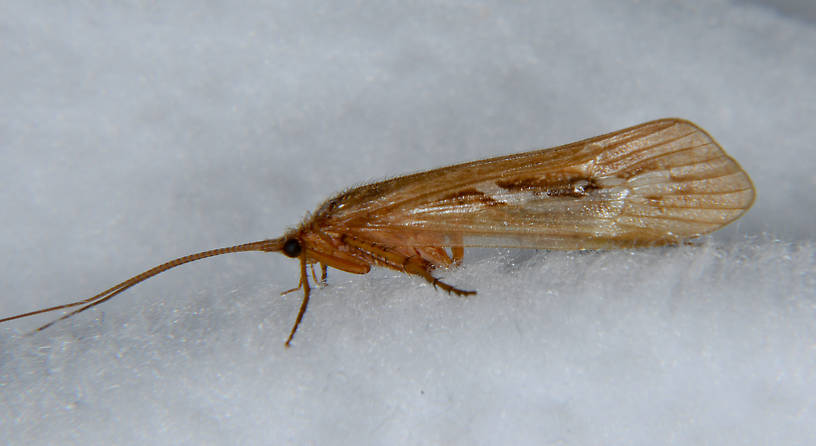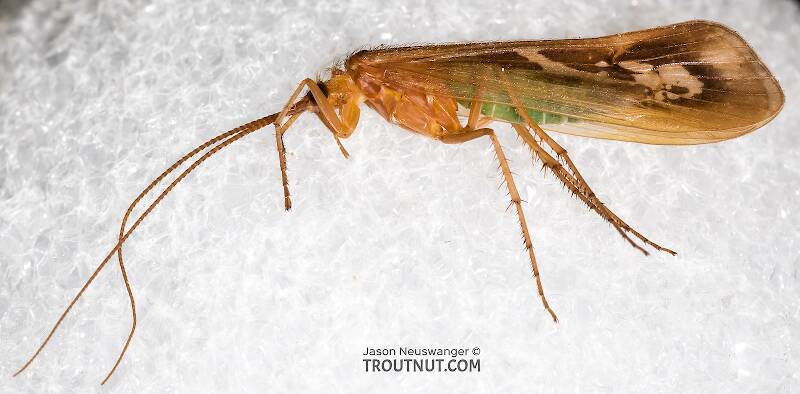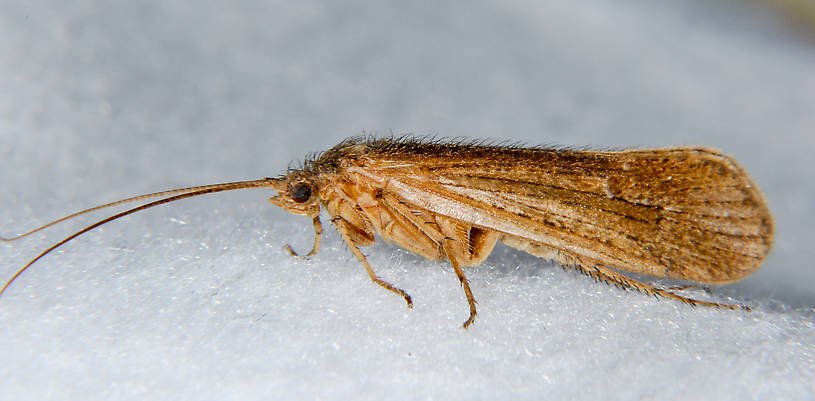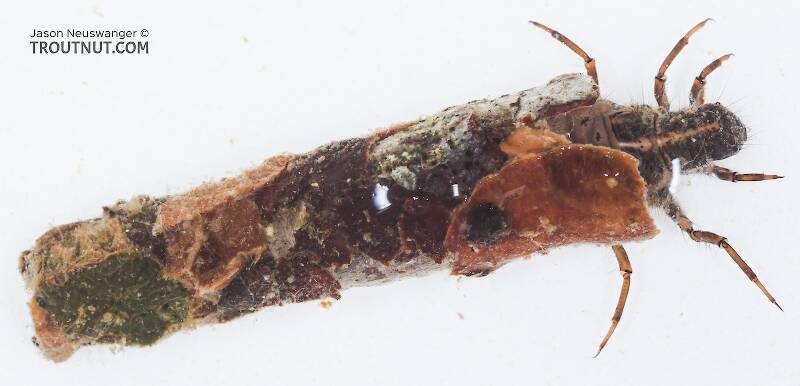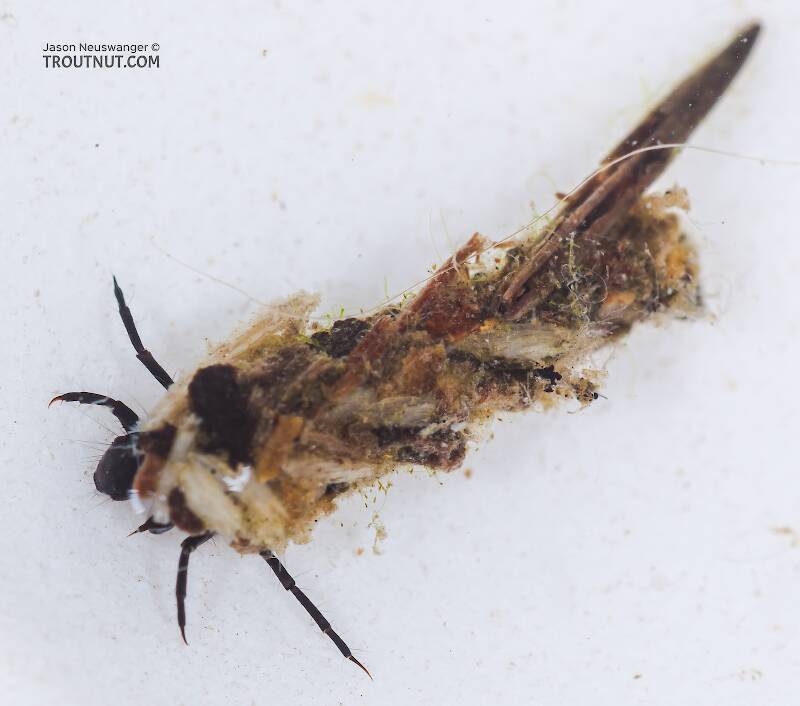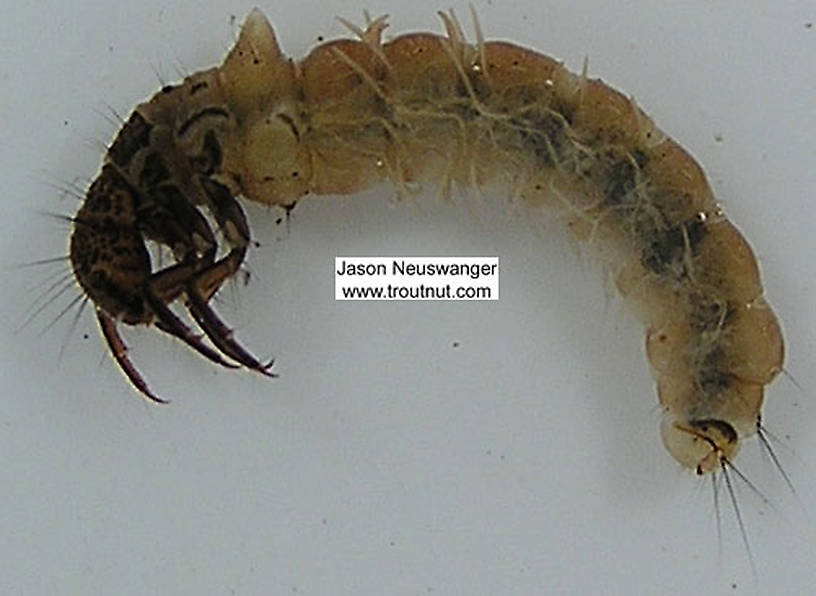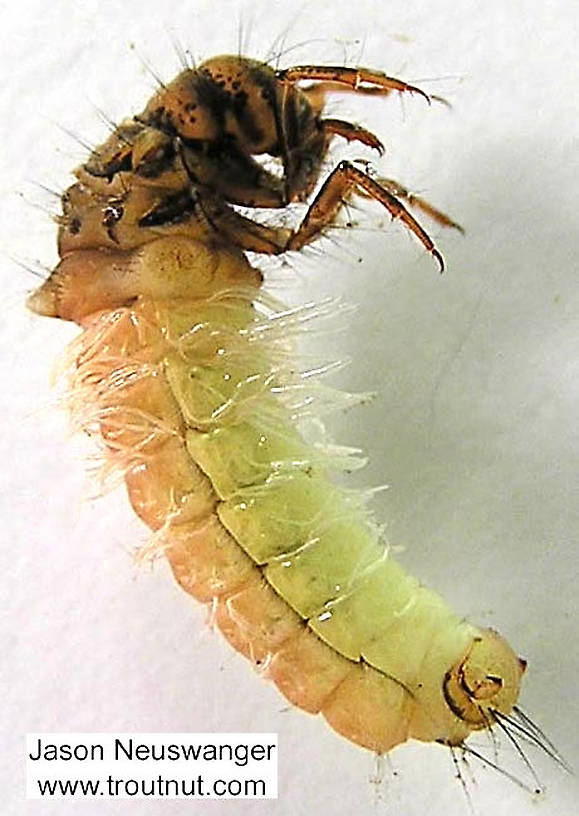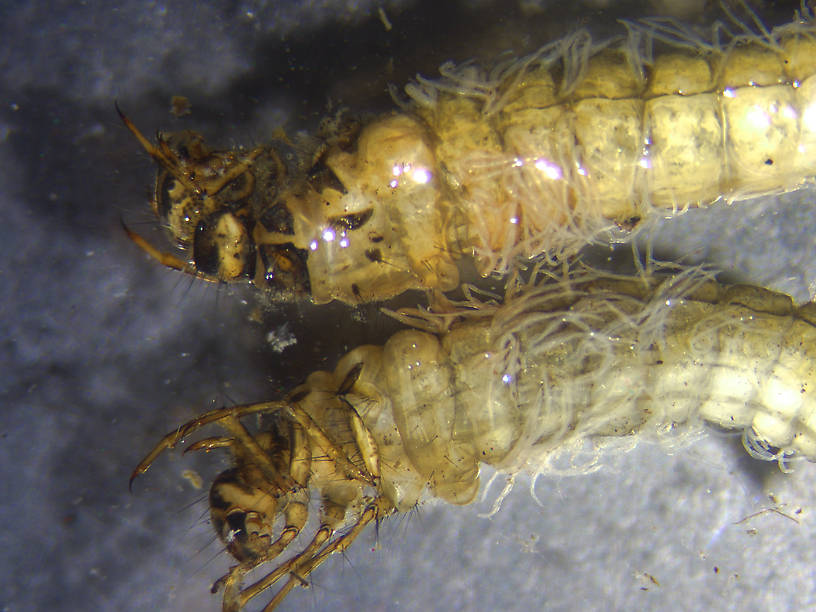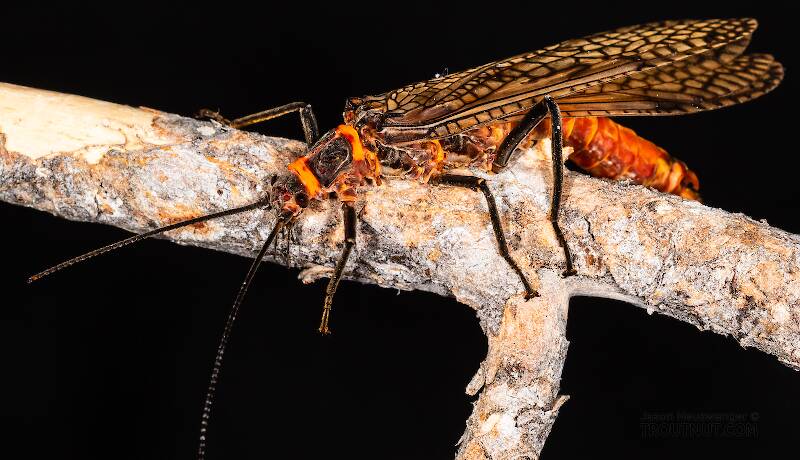
Salmonflies
Pteronarcys californica
The giant Salmonflies of the Western mountains are legendary for their proclivity to elicit consistent dry-fly action and ferocious strikes.
Featured on the forum
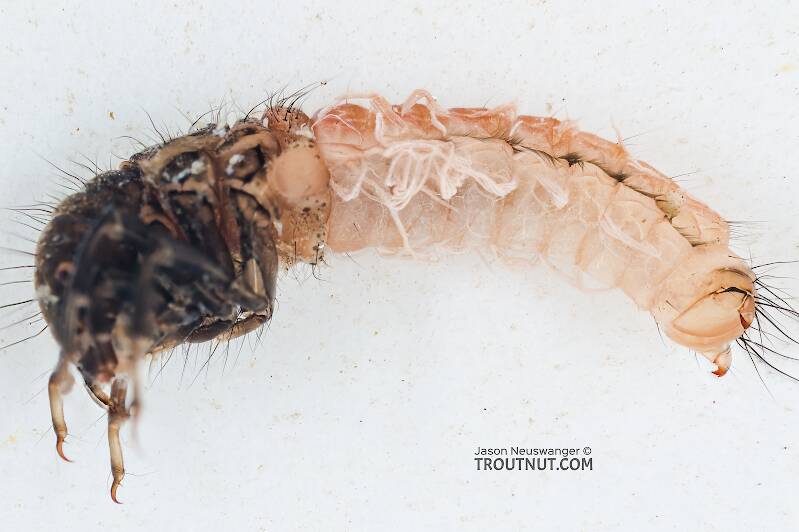
This specimen keys pretty easily to Onocosmoecus, and it closely resembles a specimen from Alaska which caddis expert Dave Ruiter recognized as this genus. As with that specimen, the only species in the genus documented in this area is Onocosmoecus unicolor, but Dave suggested for that specimen that there might be multiple not-yet-distinguished species under the unicolor umbrella and it would be best to stick with the genus-level ID. I'm doing the same for this one.
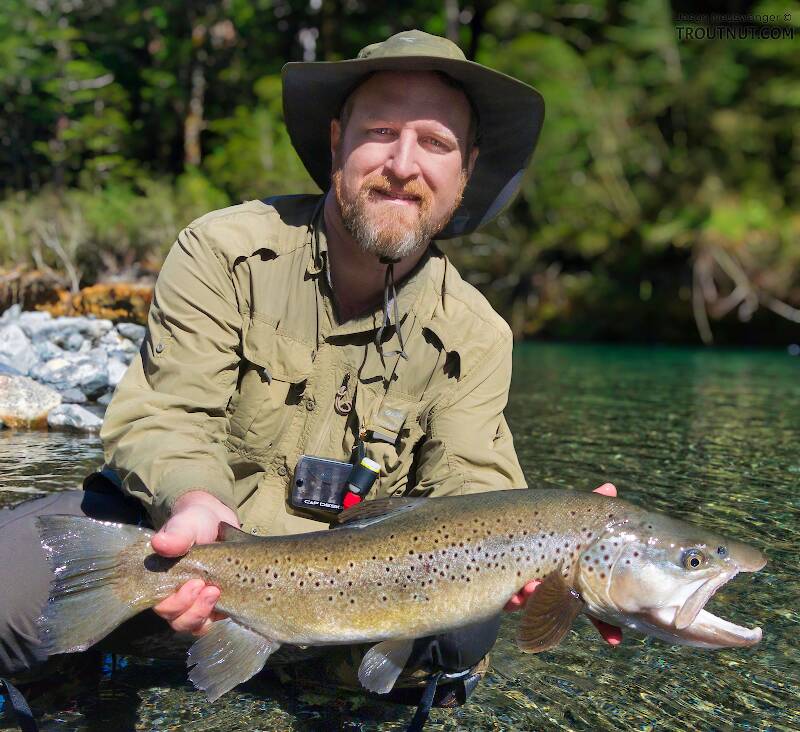
Troutnut is a project started in 2003 by salmonid ecologist Jason "Troutnut" Neuswanger to help anglers and
fly tyers unabashedly embrace the entomological side of the sport. Learn more about Troutnut or
support the project for an enhanced experience here.
Caddisfly Genus Limnephilus (Summer Flier Sedges)
This prolific genus is most important in lakes, spring ponds, and beaver ponds, but some of its species do well enough in spring creeks and slow pools to be important to trout there.
Where & when
Most of these species emerge in late spring or early summer, but the adults are not mature (sort of like mayfly duns, except they don't need to molt again). They mature over the summer and mate in the fall.
According to Swisher and Richards in Selective Trout, some Limnephilus species are multibrooded, with one spring generation and one fall generation. This seems very strange for a large caddisfly, and I wonder if they mistook the spring emergence and fall egg-laying for different broods.
In 1967 records from GBIF, adults of this genus have mostly been collected during August (27%), July (24%), June (18%), September (15%), October (7%), and May (5%).
In 1099 records from GBIF, this genus has been collected at elevations ranging from -30 to 38927 ft, with an average (median) of 1047 ft.
Genus Range
Egg-Laying behavior
LaFontaine writes in Caddisflies that they lay their eggs "near the water."Larva & pupa biology
Shelter type: Thick tubes of stone, sand, bark, or wood
Specimens of the Caddisfly Genus Limnephilus
1 Adult
1 Male Adult
1 Female Adult
5 Larvae
Start a Discussion of Limnephilus
References
- LaFontaine, Gary. 1981. Caddisflies. The Lyons Press.
- Schwiebert, Ernest G. 1955. Matching the Hatch. MacMillan Publishing Company.
- Swisher, Doug and Carl Richards. 2000. Selective Trout. The Lyons Press.
Caddisfly Genus Limnephilus (Summer Flier Sedges)
Taxonomy
Species in Limnephilus
Limnephilus externus
3
7
Limnephilus frijole
1
1
Limnephilus indivisus
0
0
Limnephilus sericeus
0
0
Limnephilus spinatus
0
0
Limnephilus submonilifer
0
0
Limnephilus thorus
0
0
Species in Limnephilus: Limnephilus externus, Limnephilus frijole, Limnephilus indivisus, Limnephilus sericeus, Limnephilus spinatus, Limnephilus submonilifer, Limnephilus thorus
102 species (Limnephilus abbreviatus, Limnephilus acnestus, Limnephilus acrocurvus, Limnephilus acula, Limnephilus adapus, Limnephilus ademus, Limnephilus alberta, Limnephilus alconura, Limnephilus alvatus, Limnephilus apache, Limnephilus aretto, Limnephilus argenteornatus, Limnephilus argenteus, Limnephilus arizona, Limnephilus assimilis, Limnephilus atercus, Limnephilus bifidus, Limnephilus bucketti, Limnephilus canadensis, Limnephilus castor, Limnephilus catula, Limnephilus cerus, Limnephilus challisa, Limnephilus chavas, Limnephilus chilcotinensis, Limnephilus cockerelli, Limnephilus coloradensis, Limnephilus concolor, Limnephilus congener, Limnephilus diphyes, Limnephilus dispar, Limnephilus diversa, Limnephilus ectus, Limnephilus elongatus, Limnephilus extractus, Limnephilus fagus, Limnephilus femoralis, Limnephilus fenestrata, Limnephilus fumosus, Limnephilus gioia, Limnephilus granti, Limnephilus hageni, Limnephilus harrimani, Limnephilus hyalinus, Limnephilus infernalis, Limnephilus innuitorum, Limnephilus insularis, Limnephilus isobela, Limnephilus janus, Limnephilus kalama, Limnephilus kennicotti, Limnephilus labus, Limnephilus litha, Limnephilus loloensis, Limnephilus lopho, Limnephilus lunonus, Limnephilus miser, Limnephilus moestus, Limnephilus morrisoni, Limnephilus moselyi, Limnephilus neoacula, Limnephilus nigriceps, Limnephilus nimmoi, Limnephilus nogus, Limnephilus occidentalis, Limnephilus ornatus, Limnephilus pallens, Limnephilus partitus, Limnephilus parvulus, Limnephilus peltus, Limnephilus perjurus, Limnephilus perpusillus, Limnephilus picturatus, Limnephilus plaga, Limnephilus productus, Limnephilus rhombica, Limnephilus rohweri, Limnephilus rossi, Limnephilus rothi, Limnephilus sackeni, Limnephilus saltus, Limnephilus samoedus, Limnephilus sansoni, Limnephilus santanus, Limnephilus secludens, Limnephilus selatus, Limnephilus sierrata, Limnephilus sitchensis, Limnephilus solidus, Limnephilus stigma, Limnephilus sublunatus, Limnephilus susana, Limnephilus sylviae, Limnephilus taloga, Limnephilus taronus, Limnephilus tarsalis, Limnephilus toussainti, Limnephilus tulatus, Limnephilus uintah, Limnephilus valhalla, Limnephilus vernalis, and Limnephilus whiteheadi) aren't included.


